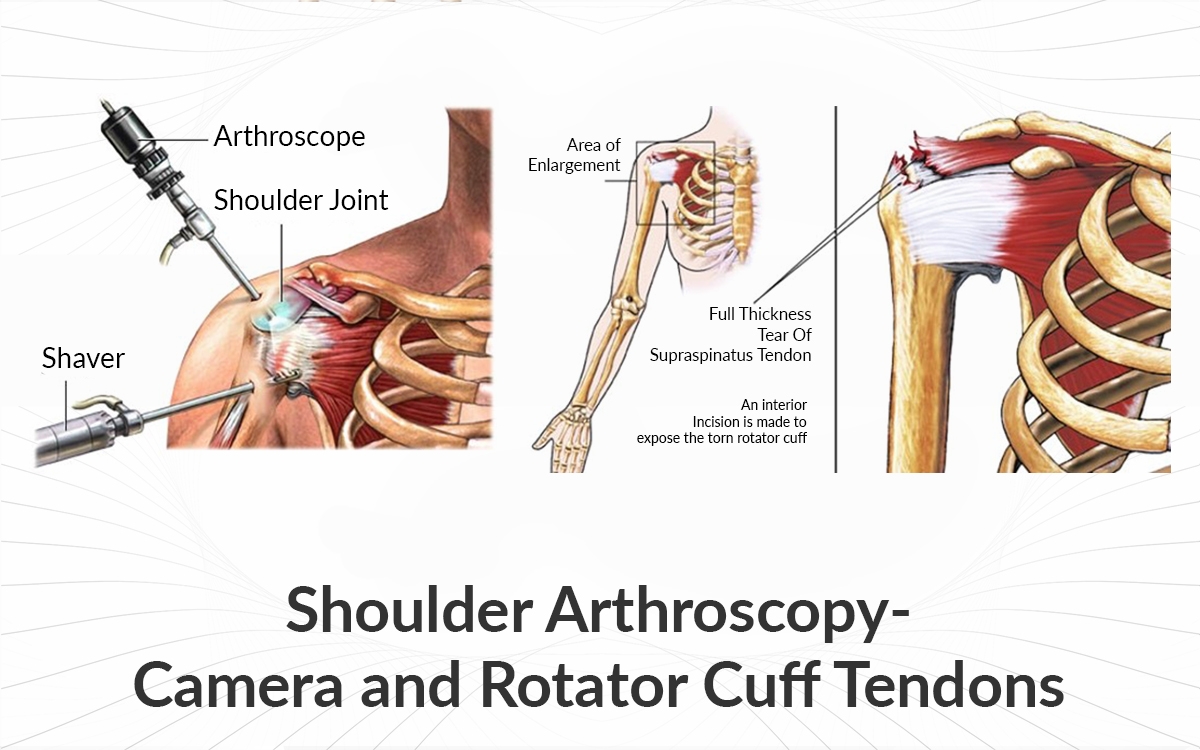
Summary
Surgery is a recommended if
- Continued pain for more than 6-12 months despite physiotherapy, steroid injections
- Pain, weakness and loss of function in the shoulder
Kinds of repairs
- Arthroscopic repair
- Mini open repair
- Traditional open repair
Surgery involves
- For repair of a torn rotator cuff – reattaching the tendon to the head of humerus (upper arm bone)
- For a partial tear – trimming or smoothing procedure called a debridement
What is an Arthroscopic Rotator Cuff Repair?
A rotator cuff is the name given to the four tendons in your shoulder. These tendons are responsible for different movements to your shoulder like, elevation and rotation. Any of the above four tendons can tear. Most common tendon to tear is the supraspinatus tendon which can happen due to an injury or most commonly due to wear and tear that occurs as part of the ageing process.
When a tendon tears it can no longer function properly and can result in pain and weakness.
During an arthroscopic rotator cuff surgery, a camera (arthroscope) is inserted into the shoulder to allow the tendons to be seen. Fluid (saline) is passed into the shoulder during the surgery to allow the surgeon to look at the structures within it. Small anchors are then used to repair the torn tendon back onto the bone. Stitches (sutures) are also passed through the tendon to secure it.
Surgery to repair a torn rotator cuff most often involves reattaching the tendon to the head of humerus (upper arm bone). A partial tear however, may need only a trimming or smoothing procedure called a debridement. A complete tear will be repaired by stitching the tendon back to its original site on the humerus using anchor and stitches.
When is the Rotator Cuff surgery recommended?
Surgery is usually recommended if your tear is caused by a recent injury like whilst playing sports or lifting anything heavy. Situations where surgery is a good option include the continued pain for more than 6-12 months despite physiotherapy, steroid injections or if you have pain, weakness and loss of function in your shoulder.
What are the benefits of having an Arthroscopic Rotator Cuff Surgery?
The main aim of the surgery is to provide pain relief. We will also repair the tendon at the same time which will make your shoulder strong and will give you a better range of movement. This will help you to manage your day to day activities better.
What are the options for surgical repair?
There are various options like arthroscopic repair, mini open repair or a traditional open repair. Surgical technique will depend on your surgeons experience and familiarity with a particular procedure and also dictated by the size of the tear, the tendon involved and the quality of tendon tissue and bone.
Technique of repair will also depend on if you have any other associated shoulder problems like biceps tendon tear, osteoarthritis, bony burrs, other soft tissue tears etc.
What are the complications of arthroscopic surgery?
In general the risks of any operation include the anaesthetic risks and the surgical risks. You will be seen by an anaesthetist and your surgeon on the day of your surgery who will discuss the complications. Complications can include infection, damage to nerves, bleeding, blood clots, re-tear of the tendons, stiffness of the shoulder. Altogether the risks are around 4 – 5%.
What will happen after the operation?
After the surgery you will have some pain which is a natural part of the healing process. You will be prescribed opioids and non-steroid anti-inflammatory drugs to manage your pain. As soon as your pain starts to lessen, stop taking opioids to prevent any opioid dependency.
Before you leave hospital you will be seen by a physiotherapist who will show you shoulder exercises and discuss further rehabilitation with you. You will be given a sling which you will have to use for 4- 6 weeks. It takes roughly two weeks for your wound to heal up. It takes ten weeks for your tendon to glue to the head of humerus (upper arm bone). You will start with gentle pendulum exercises for the first two weeks. After two weeks you will be allowed active range of movements. From three months you will start resistance exercises.
What do I do after I go home?
You will need to keep your wound dressing dry for two weeks. Bulky dressing will come off in two days’ time. You will be given an appointment to see your consultant in two weeks’ time for a wound check and removal of stitches. You will be asked to wear a sling for 4-6 weeks. You can drive at around six weeks’ time. Resistance exercises after 3 months. Your shoulder will continue to improve for 9-10 months.
What are the outcomes like?
In the majority of patients pain improves and shoulder range of motion and strength increases. Factors that decrease the likelihood of a good result include massive tears with poor tendon quality. Increasing age, smoking or poor patient compliance with rehabilitation can also affect the outcome.
BMI Chelsfield Park Hospital
Bucks Cross Road Chelsfield ORPINGTON BR6 7RG
01689 877855
BMI The Blackheath Hospital
40-42 Lee Terrace Blackheath LONDON SE3 9UD
020 8318 7722
BMI The Sloane Hospital
125 Albemarle Road BECKENHAM BR3 5HS
020 8466 4000
Princess Royal University Hospital
Farnborough Common ORPINGTON BR6 8ND
01689 863223


 info@drsaurabhaggarwal.com
info@drsaurabhaggarwal.com